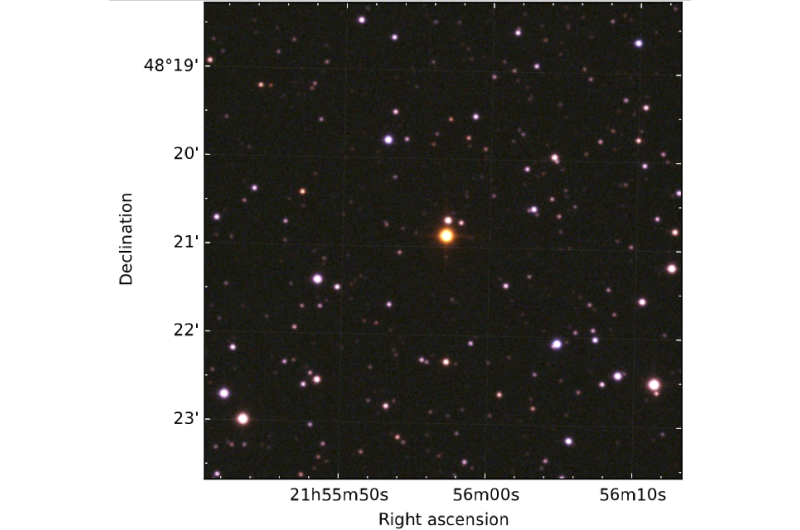November 17, 2015 report
We are all stardust—carbon star LX Cygni provides insights on the chemical evolution of the universe

(Phys.org)—A carbon star is a giant red star nearing the end of its life, with an atmosphere containing more carbon than oxygen. LX Cygni could be an interesting example of an object that is currently in the process of transitioning into a carbon star. An international team of astronomers, led by Stefan Uttenthaler of the University of Vienna, has recently published a paper on Arxiv describing LX Cygni as a new carbon star being born, that could help us collect substantial information regarding the chemical evolution of the universe.
"These observations are important to understand the chemical evolution of the universe, because most of the carbon in the universe is thought to come from stars just like LX Cygni," Uttenthaler told Phys.org.
Carbon, the fourth most abundant element in the universe, is the key component for all known life on Earth. It is assumed that if life exists somewhere else in the universe, it will also be carbon based.
"Carbon is a very important element because it is key to all forms of life as we know it. Most of the carbon in our bodies comes from an earlier generation of stars such as LX Cygni. We are literally stardust!" Uttenthaler added.
Uttenthaler and his colleagues noted that carbon stars are a special class of stars that have a chemical composition that is distinct from that of other stars throughout the universe. In most stars, including our sun, oxygen is more abundant than carbon, as measured by the carbon/oxygen ratio. They underline the importance of the observations of LX Cygni as it is a rare case of a star enabling observations of stellar evolution in real time. The study of its general properties and evolution may lead to unique insights into the transition from oxygen rich to carbon-rich stars.
"These observations tell us quite something about stellar evolution because, if our interpretation of the observations is correct, it tells us something about how the short but decisive evolution from oxygen- to carbon-rich phase happens. Many stars in the universe are thought to go through this evolution and it is predicted by theory, yet few observations have really caught a star in the act of this evolution. We now have a glimpse at this phase, we can see stellar evolution in real-time," Uttenthaler said.
The researchers obtained optical high- and low-resolution spectra as well as mid-resolution infrared spectra to investigate LX Cygni's spectral features. These observations indicated a dramatic increase of the star's pulsation period in recent decades so the scientists concluded that LX Cygni appears to undergo an important transition in its evolution. They believe that is related to a process that brought up carbon from the interior of the star and a genuine abundance change happened.
Uttenthaler revealed that it must have happened quickly when compared to other processes in a star's lifetime.
"The whole process seems to have taken only some 30 years," he said.
Unfortunately, he admitted that it is not possible to determine precisely how fast it was because the star has received little observational attention in the past.
What is interesting is that LX Cygni's transition process may be already completed. The observations conducted in 2008, using NASA's Spitzer telescope, suggest that LX Cygni was a carbon star at that time. To resolve all the uncertainties, Uttenthaler's research team recommends that the community continues observing this star, most importantly to conduct observations in the mid-infrared and in the radio regime to study the dust and molecular composition of the circumstellar envelope of LX Cygni.
"From this, we would learn what the chemical composition and the mass-loss rate of the star was in the past, how the dust and molecular inventory of the star evolved over the past few thousand years. This would be extremely interesting to know!" Uttenthaler said.
More information: LX Cygni: A carbon star is born, arXiv:1511.02159 [astro-ph.SR] arxiv.org/abs/1511.02159v2
Abstract
The Mira variable LX Cyg showed a dramatic increase of its pulsation period in the recent decades and appears to undergo an important transition in its evolution. Aims: We aim at investigating the spectral type evolution of this star over the recent decades as well as during one pulsation cycle in more detail and discuss it in connection with the period evolution. Methods: We present optical, near- and mid-IR low-resolution as well as optical high-resolution spectra to determine the current spectral type. The optical spectrum of LX Cyg has been followed for more than one pulsation cycle. Recent spectra are compared to archival spectra to trace the spectral type evolution and a Spitzer mid-IR spectrum is analysed for the presence of molecular and dust features. Furthermore, the current period is derived from AAVSO data. Results: It is found that the spectral type of LX Cyg changed from S to C sometime between 1975 and 2008. Currently, the spectral type C is stable during a pulsation cycle. It is shown that spectral features typical of C-type stars are present in its spectrum from ~0.5 to 14 μm. An emission feature at 10.7 μm is attributed to SiC grains. The period of LX Cyg has increased from ~460 d to ~580 d within only 20 years, and is stable now. Conclusions: We conclude that the change in spectral type and the increase in pulsation period happened simultaneously and are causally connected. Both a recent thermal pulse (TP) and a simple surface temperature decrease appear unlikely to explain the observations. We therefore suggest that the underlying mechanism is related to a recent third dredge-up mixing event that brought up carbon from the interior of the star, i.e. that a genuine abundance change happened. We propose that LX Cyg is a rare transition type object that is uniquely suited to study the transformation from O- to C-rich stars in detail.
Journal information: arXiv
© 2015 Phys.org




















